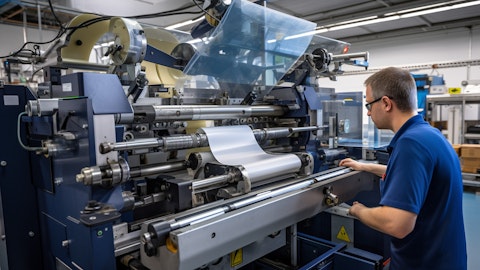Old Republic International Corporation (NYSE:ORI) Q3 2025 Earnings Call Transcript October 23, 2025
Old Republic International Corporation beats earnings expectations. Reported EPS is $0.78, expectations were $0.73.
Operator: Thank you for standing by. My name is Tina, and I will be your conference operator today. At this time, I would like to welcome everyone to the Old Republic International Third Quarter 2025 Earnings Conference Call. [Operator Instructions] It is now my pleasure to turn the call over to Joe Calabrese with MWW.
Joe Calabrese: Thank you, Tina. Good afternoon, everyone, and thank you for joining us for the Old Republic conference call to discuss third quarter 2025 results. This morning, we distributed a copy of the press release and posted a separate financial supplement. Both of the documents are available on Old Republic’s website at www.oldrepublic.com. Please be advised that this call may involve forward-looking statements as discussed in the press release dated October 23, 2025. Assumptions, uncertainties and risks exist that may cause results to differ materially from those set forth in these forward-looking statements. For more information on these assumptions, uncertainties and risks, please refer to the forward-looking statement discussion in the press release and the company’s other recent SEC filings, and the risk factors discussed in the company’s most recent Form 10-K and other recent SEC filings.
We may also include references to net income excluding net investment gains, or net operating income, a non-GAAP financial measure, in our remarks or in responses to questions. GAAP reconciliations are included in the press release. Presenting on today’s conference call will be Craig Smiddy, President and CEO; Frank Sodaro, Chief Financial Officer; and Carolyn Monroe, President and CEO of Old Republic’s National Title Insurance Group. Management will make some opening remarks and then we’ll open the line for your questions. At this time, I’d like to turn the call over to Craig. Please go ahead, sir.
Craig Smiddy: Okay. Thank you, Joe. Good afternoon, everyone, and welcome again to Old Republic’s third quarter 2025 earnings call. In addition to our earnings release, we also issued a separate news release this morning regarding our agreement to purchase Everett Cash Mutual through a sponsored demutualization. We think this is reflective of our commitment to continue to pursue profitable growth of our specialty insurance business. ECM, as it’s referred, is a leading insurer of farm and agricultural operations nationwide, writing $237 million of direct premium in 2024. We also added a new slide on ECM to the appendix of our investor presentation on our website, so there’s more there for you to see if you’re so interested. Strategically, ECM fits very nicely into our Specialty Insurance portfolio given our close cultural alignment and their narrow and deep focus on farm and ag specialty.
ECM provides for further product diversification within our existing specialty insurance business. And we will not compete with any of ECM’s current offerings or vice versa. So once the transaction closes, we expect ECM to be very well positioned from a capital and product perspective to pursue profitable growth geographically and through new product offerings. So we’re very happy to have the ECM folks join the Old Republic family. So now turning to the earnings release. Our story of solid growth and profitability continued through the third quarter as we produced $248.2 million of consolidated pretax operating income. That’s up from $229.2 million in the third quarter of ’24. Our consolidated combined ratio was 95.3%, and that compares to 95% in the third quarter of last year.
On our balance sheet, it remains strong, while we continue to invest in new specialty operating companies, make ongoing technology investments and also invest in talent across the organization. Our annualized operating return on beginning equity improved to an annualized rate of 14.4%, and that compares to 11.9% in the third quarter last year, which we think reflects our strong operating earnings and thoughtful management of capital. In Specialty Insurance, we grew net premiums earned by 8.1% compared to the third quarter of ’24 when we produced $207 million of pretax operating income, up from $197.3 million in the third quarter last year. The Specialty Insurance combined ratio was at 94.8% in the quarter, compared to 94% in the third quarter last year.
Despite the continuation of a slow real estate market, Title Insurance grew premium and fees by 8.3% compared to the third quarter last year; and produced $45.7 million of pretax operating income, and that’s up from $40.2 million in the third quarter last year. The Title Insurance combined ratio was — or excuse me, 96.4% in the quarter, and that compares to 96.7% in the third quarter last year. Our conservative reserving practices continue to produce favorable prior year loss reserve development in both Specialty Insurance and Title Insurance, and Frank will provide more details around that topic. So with that, I’ll turn the discussion over to Frank. And then Frank will turn things back to me to discuss Specialty Insurance, followed by Carolyn, who will discuss Title Insurance.
And then as the operator says, we will open it up for Q&A. So Frank?
Francis Sodaro: Thank you, Craig, and good afternoon, everyone. This morning, we reported net operating income of $197 million for the quarter, compared to $183 million last year. On a per share basis, comparable quarter-over-quarter results were $0.78, compared to $0.71, a 10% increase. Net investment income increased 6.7%, primarily as a result of higher yields on the bond portfolio. Our average reinvestment rate on corporate bonds acquired during the quarter was 4.7%, compared to the average yield rolling off of about 4.1%. The total bond portfolio book yield stands at 4.7%, compared to 4.5% at the end of last year. Turning now to loss reserves. Both Specialty Insurance and Title Insurance recognized favorable development in the quarter, leading to a benefit in the consolidated loss ratio of 2.5 percentage points, compared to 1.3 points of favorable development last year.

Within Specialty Insurance, workers’ comp continued to have significant favorable development and accounted for the majority of the group’s total favorable development. Commercial auto, general liability and property all had favorable development in the quarter. As we have mentioned in the past, general liability is a relatively small but growing line that does have some quarter-to-quarter volatility. This quarter, GL had favorable development, and the year-to-date impact was negligible on the Specialty Insurance loss ratio. We ended the quarter with book value per share of $26.19, which, inclusive of the regular dividend, equated to an increase of 18.5% year-to-date. That resulted primarily from our strong operating earnings and higher investment valuations.
In the quarter, we paid $71 million in regular cash dividends and repurchased $44 million worth of our shares. We did not repurchase additional shares since the end of the quarter, leaving us with just over $910 million remaining on our current repurchase program. The recently launched operating companies and the ECM acquisition do not materially hinder our ability to return capital. So as usual, we will be discussing with our Board of Directors the most efficient way to return capital by the end of the year. I’ll now turn the call back over to Craig for a discussion of Specialty Insurance.
Craig Smiddy: Okay. Frank, thanks for that summary. Specialty Insurance net written premiums were up 6.9% in the third quarter, with strong rate increases on commercial auto and general liability, that I’ll talk about momentarily. We had solid renewal retentions, strong new business writings and an increasing amount of premium in our new specialty operating companies. As mentioned in my opening remarks, in the third quarter, Specialty Insurance pretax operating income was $207.7 million, and the combined ratio was 94.8%. The loss ratio for the third quarter was 63.5%. That included 3.4 percentage points of favorable prior year loss reserve development, compared to 65.2% in the third quarter last year, which included 1.7 points of favorable development.
The expense ratio was 31.3% in the third quarter, compared to 28.8% last year, primarily reflecting higher personnel expenses, including those within our newest specialty operating companies not yet producing premium, and ongoing investments in technology. For note, the year-to-date expense ratio and loss ratio tend to be better indications of run rates, and they also reflect changes in our mix of business toward lower loss ratios and higher commission ratios. Now to give you some details around our 2 largest lines of business: commercial auto and workers’ compensation. Commercial auto net premiums written grew 7% in the third quarter, while the loss ratio came in at 68.3%, compared to 67.1% last year. Rate increases remained at the 14% level, which is the same we saw in the second quarter, and that’s commensurate with the loss severity trend we’re observing.
Switching to workers’ compensation. Net premiums written grew 6.7% in the third quarter, while the loss ratio came in at 63.8%, compared to 58.8% last year. Rates continue to remain relatively flat. And here too, that’s consistent with what we observed in the second quarter. Loss frequency trend continues to decline, more than offsetting the increase in loss severity trend. So given the positive wage trend within payroll, and again that’s what we apply our rates to, a declining loss frequency trend and a relatively stable loss severity trend, we think our rate levels continue to remain adequate. So we expect solid growth and profitability in Specialty Insurance to continue, reflecting the success of our specialty strategy and our growing contributions from our new specialty operating companies.
Our operational excellence initiatives continue to contribute to this profitable growth by leveraging Old Republic’s collective knowledge and expertise. And we also here too included a new slide on these initiatives in the appendix of our investor presentation on our website. So that concludes my remarks on Specialty Insurance, and I’ll now turn the discussion over to you, Carolyn, to report on Title Insurance.
Carolyn Monroe: Thank you, Craig, and good afternoon, everyone. Title reported premium and fee revenue for the quarter of $767 million. This represents an increase of 8% from third quarter of last year. The third quarter market story is a continuation of what we reported last quarter. We still see strong activity in the commercial sector, a modest uptick in refinance activity, and a softness in the residential purchase market driven by persistent price and affordability challenges. Overall, we are pleased with our revenue improvement during the year. Premiums from our direct Title operations were up 8% from third quarter of last year. Agency produced premiums were up 11% and made up nearly 80% of our revenue during the quarter, up from 78% during third quarter of 2024.
Commercial premiums increased this quarter and were 26% of our earned premiums, compared to 20% in the third quarter of last year. Investment income was also up this quarter, by nearly 11%, compared to third quarter 2024, primarily reflecting higher investment yields earned. Our overall loss ratio decreased to 2.7% this quarter, compared to 2.8% in the third quarter of 2024. The slight improvement relates to continued favorable development in prior policy years. Agency premiums accounted for a larger share of our revenue this quarter, raising agent commissions and increasing our expense ratio by 1.9%. The remainder of our expenses decreased by 2.1% relative to premiums and fees. These changes led to a combined ratio of 96.4% for this quarter, an improvement over both last quarter and the 96.7% reported in the third quarter of 2024.
Pretax operating income this quarter was $46 million, compared to $40 million in third quarter of last year. During the quarter, we continued progressing with the advancement of digital transaction tools and solutions for our direct operations and title agents through our strategic partnerships. We remain focused on the importance of providing our agents with the innovative technological solutions required to maintain a competitive edge. Thank you. And with that, I will turn it back to Craig.
Craig Smiddy: Okay. Thank you, Carolyn. Well, that concludes our prepared remarks. So we’ll now open up the discussion to Q&A where I’ll try to answer your questions or I’ll ask Frank or Carolyn for some help.
Q&A Session
Follow Old Republic International Corp (NYSE:ORI)
Follow Old Republic International Corp (NYSE:ORI)
Receive real-time insider trading and news alerts
Operator: [Operator Instructions] And our first question comes from the line of Gregory Peters with Raymond James.
Charles Peters: For my first question, I want to go back to Frank’s comments on capital. And I guess what I’m looking for is just how you are measuring excess capital, because it seems like there’s a shift. Or maybe put it a different way, maybe your — there’s been a strategic decision not to hold as much excess capital. But either way, I’m just looking for how you’re measuring capital right now. Is it reserves — based on reserves, or what the ratios you’re looking at and how you’re thinking about excess capital in the context of what Frank was saying in the fourth quarter?
Craig Smiddy: Yes, Greg. I’ll start, and if Frank has anything to add, he can add it. Last year when we declared the $2 special dividend, we made note that we had this nice problem of continuing to have operating income retained earnings that were building faster than we could return capital to shareholders either through share repurchases or dividends. And so we issued a special dividend. When we contemplate that and discuss that with our Board, we look at several different enterprise risk management measures. And one of those is certainly the amount of capital we hold relative to the reserves. But there’s been no major shift at all. It’s really just a matter of, again, having a nice problem where we continue to just build capital faster than we could deploy it.
So as we sit here this year, the same kind of thing has happened. We have built up capital again, and we have done so faster than we’re able to return it through share repurchases or ordinary dividends. So as Frank indicated, it’s a matter that, as we always do, we’ll take up with our Board and suggest the best ways to return that to shareholders in a way that is most productive for the shareholders. So that’s, again, no shift. We continue to look at multiple different metrics when we look at capital and we manage it thoughtfully as I indicated in my comments, and do a significant amount of analysis and make recommendations accordingly to our Board.
Charles Peters: Great. And I was looking over your slide on Everett, and just curious if you could tell us a little bit more about this entity. You highlighted that there’s not a lot of crossover in terms of product. So I’m just curious how you’re thinking about this business and how it’s going to sit inside Old Republic. And when — more importantly, I know you’ve got these start-up operating companies, the 5 that you’ve outlined, does this become #6 as you branch off into some other types of businesses? So just some more color there would be helpful.
Craig Smiddy: Sure, sure. So I’ll start with the latter part of your question. And that is we definitely look at it as a new operating company within our existing portfolio of operating companies. I think that would take us up to 18 companies within our Specialty Insurance, and then, of course, our Title Insurance being our 19th. So one of the things that was very, I think, attractive to ECM was that decentralized model and the degree of independence and accountability that we give to each of those operating companies. And as I mentioned as well, just a strong cultural alignment of integrity and transparency and the other components of our cultural tenets that we share. So as far as the business itself, we, again, are thinking that it is very complementary, doesn’t compete with our existing segments.
It’s a specialty segment in the marketplace. And that is the sole focus of Everett, which is exactly what our strategy is, and that is for our each of those 18 different operating companies to be an inch wide, mile deep in their specialty, focused very narrowly on what they do and do it better than anybody else. And ECM checks every one of those boxes. So I guess getting into more of the technicals, as I mentioned, ECM focuses on farm and ag business. And in that portfolio, farm owners and commercial, multi-peril make up 70% of their coverages, with inland marine and commercial auto each making up about 9% of their coverages. And another important attractive note is that their business skews more toward short-tail lines of coverage, which a lot of the new companies that we’ve added lately to diversify our portfolio have been, which is short tail kind of line, so you have a much faster understanding of how the business is performing.
And again, we intend to give ECM the capital necessary to continue to drive expansion of their business. We expect they’ll do that through geographic expansion. They started some geographic expansion by making an acquisition in late 2022 when they made an acquisition that allowed them to expand westward. And I think another attribute that is shared is they compete on the basis of expertise, relationships, ease of doing business around their specialty niche, just like all of our specialties. So again, their profile is very consistent with the profile of our existing specialty companies. And as such, we just think it’s a perfect fit.
Charles Peters: Excellent. And I — just pivot to the Title business, my final question. Hope springs eternal that things and market will turn on the residential side. In the interim, I know you addressed this last conference call, in Texas there were some challenges on some rate rollbacks. I’m wondering if you’re seeing any other regulatory pressures build up in any other states, or is it just normal operating status everywhere else?
Craig Smiddy: Yes. I think it’s been fairly consistent. Nothing significant has emerged. But Carolyn, you’re much closer to the action than I am, so I’ll turn it to you to maybe add any color you might have.
Carolyn Monroe: Greg, no, it’s been fairly quiet on the regulatory front, nothing out of the ordinary. Still waiting on the Texas. It was appealed. There was supposed to be a hearing in December, but really no word on that yet. But that’s the only thing that’s out there brewing right now.
Operator: And our next question comes from the line of Paul Newsome with Piper Sandler.
Jon Paul Newsome: I want to beat on the ECM dead horse a little bit more. I don’t know if we’ll actually get more precise numbers, but I’d like to know how this fits in with — a little bit better with how it fits into the capital decisions that you’re going to be making in the near future. I mean, I would imagine ECM is going to cost at least the statutory capital for you, folks. And then it sounds like — again, correct me if I’m wrong in these assumptions, that there’s an intention to put more capital into ECM. And then I guess, on top of that, you have whatever is left in your view of excess capital. And so I guess the questions are, are those the right pieces I should be looking at? And then can we talk about sort of like potential timing for those things?
It sounds like ECM is going to close sometime in ’26. I don’t know if that means you’ll hold on to capital a little bit longer this time around than some of the more speedy things you’ve done in the past at year-end. It’s about 5 questions in there, I apologize.
Craig Smiddy: Yes. I think we follow, though. Well, as we indicated in the release, we expect this to be accretive to book value per share. So you can infer from there that it is not — will not be at least the amount of their statutory capital. And that is because of the structure of a sponsored demutualization. So from a high-level standpoint, the sponsored demutualization is not going to affect our view of capital as we get to that analysis with our Board and look at things — how things look at the end of the year. There’s really no consideration in that analysis of capital needs in order to follow through on the sponsored demutualization. Through that sponsored demutualization, ECM will end up with additional capital and that is what will enable them to pursue growth opportunities.
As you know, Mutual has a limited amount of ability to raise capital. And under our umbrella here at Old Republic, we will have that capital if they need it. But just through the sponsored demutualization itself, they will end up with more capital to pursue those goals. And again, on top of that, we don’t plan on contributing additional capital beyond that. So long story short, it is — really doesn’t move the needle at all when it comes to how we’re looking at our capital position and the recommendations we’ll be making with regard to returning capital to shareholders going forward.
Jon Paul Newsome: Okay. That’s great. Now follow-up questions on a different horse — beat-up horse. Yesterday night, last night, we had some not-so-happy news out of Selective about commercial auto insurance rearing an additional problem for them. And I don’t know if you can or would like to respond to that directly, but obviously, you are a big commercial auto writer. It’s a different business, I recognize that. But maybe some thoughts on what you think is going on in the commercial auto business and why you may or not be ahead of the game there.
Craig Smiddy: Sure. I’d be happy to talk about that again. We’re quite proud of where we stand relative to the industry, as I think I’ve mentioned in prior quarters. We continue to put up favorable loss reserve development on commercial auto, while many of our peers over the course of the last few years have been putting up unfavorable development. And there’s a lot of components that account for why we’re in such a strong position. Again, I would point to just first and foremost the starting point of identifying the severity trend and then getting the commensurate rate that you need. And now we’re going back 6 or 7 years, where we identified it a lot earlier than a lot of our peers and responded with rate increases to offset those trends we were seeing.
I mentioned in my opening comments, we — it’s still a problem for the industry in that we think the trend is running somewhere in the low teens and we’re getting rate increases on commercial auto of 14%. So that’s been our MO for the last 6 or 7 years. We spot the trend. We get rate increase commensurate with that trend, once you have a good starting point. And I think a lot of our peers didn’t have a good starting point because they didn’t recognize it as quickly, maybe weren’t getting the rate increases early enough and — or not getting as strong as rate increases as necessary to keep up with that trend. And then there’s other things just about the way we think about things and do business that are important. One of the things, Great West is our trucking business, and they do one thing and one thing only: long-haul trucking.
They have a team of statisticians, analysts that are relying on data and analytics to adjust their rates in real-time fashion. They don’t rely on ISO. A lot of our competitors rely on ISO. And if you’re going to write commercial auto, long-haul trucking, you’re relying on ISO, you’re already probably behind the game. So we’re real time. We have our own team. We have our own proprietary rate filings in every state. Those rate filings we have — we have 42 tiers built within our proprietary rate filings, so that we can segment our business and analyze it and apply the appropriate rate, the appropriate risk, and do that, again, in a fashion that is very responsive to what we’re seeing on trend. On the claims side, again, inch wide, mile deep. All we do is long-haul trucking claims.
We have — our folks are — we have a catastrophic team, 5 airplanes that immediately get out to catastrophic events, immediately try to get our arms around the catastrophic losses that can certainly cause significant severity in the results. Our team in claims, they have relationships with all the EPA folks within all the states. So if you have a spill, a cargo spill or something like that, we know immediately how to handle it, immediately who to talk to mitigate the amount of damage from those kinds of instances. And I could go on about just, again, how specialized we are in that space. And then lastly, I would just say it’s about reserving. It starts with case reserving. Great West is terrific at getting case reserves set to ultimate as quickly as possible.
As a matter of fact, when they get those case reserves set, unlike many in the industry, our case reserves actually run off a little bit redundant, which is unheard of. So the only IBNR we really need is for true IBNR, where we actually don’t know of an incident yet. But when we know of an incident, our case reserves are set to ultimate and set there very quickly. We don’t stair-step, as it’s so-called in the industry, like many like many do. And then when it comes to our IBNR reserving, we’ve talked about that on all of our lines, but we have a very conservative approach on our IBNR reserves whereby we’ll set a loss pick at the beginning of the year. Auto liability, we’re holding that loss pick at what we set it at, even if we see results come in that look better than expected.
If we see results that come in and we think it’s a little bit hotter than we expected, we will raise that initial loss pick. But we will not lower that initial loss pick until we get at least 3, 4 years out on commercial auto, 5 years out on workers’ compensation. So those long-tail lines, we are very conservative in how we manage IBNR, in addition to, on all of our lines of business, our new Chief Claims Officer, new being he’s been here a couple of years, came in at exactly the right time to help us address the legal system abuse issue, the severity issue, plaintiff attorney tactics. And he’s helped in that regard. But one of his main charges is to ensure all of our companies are getting case reserves set to ultimate as quickly as possible on every one of our lines of business so that we can know what we have and ultimately respond and produce the kind of results we have, and have — achieve our goal of having a couple of points of favorable development on average over time on every line of business.
Operator: [Operator Instructions] And with no further questions in queue, I will now turn the call back over to management for closing remarks.
Craig Smiddy: Okay. Well, we appreciate the interest. We appreciate the questions. And again, we look forward to welcoming the ECM stakeholders to the Old Republic family. And we also are looking forward to producing the strong profitable growth for our shareholders and all other stakeholders as well. And we look forward to reporting our year-end results next time we talk to you. So thank you very much.
Operator: Thank you again for joining us today. This does conclude today’s conference call. You may now disconnect.
Follow Old Republic International Corp (NYSE:ORI)
Follow Old Republic International Corp (NYSE:ORI)
Receive real-time insider trading and news alerts




